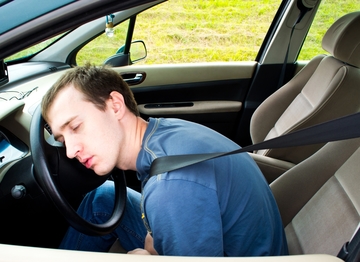
The National
Sleep Foundation says that sleep deprivation can have the same kind of
effects on your body that drinking alcohol does. This makes drowsy driving especially
dangerous.
Follow the tips and
information below from The National Highway
Traffic Safety Administration to help you avoid becoming a drowsy driver.
- The best countermeasure to drowsy driving is to get enough
rest on a daily basis. Sleep is the only
true preventative measure against the risks of drowsy driving. Make it a priority to get 7-8 hours of sleep
per night.
- Many teens do not get enough sleep at the same time that
their biological need for sleep increases, thereby increasing the risk of
drowsy-driving crashes, especially on longer trips.
- Before the start of
a long family car trip, get a good night’s sleep, or you could put your entire
family and others at risk.
- Avoid drinking any
alcohol before driving. Consumption of
alcohol interacts with sleepiness to increase drowsiness and impairment.
- If you take
medications that could cause drowsiness as a side effect, use public
transportation when possible. If you
drive, avoid driving during the peak sleepiness periods (midnight – 6 a.m. and
late afternoon).
- If you must drive
during the peak sleepiness periods, stay vigilant for signs of drowsiness, such
as crossing over roadway lines or hitting a rumble strip, especially if you’re
driving alone.
Anything
that takes your eyes off the road, your hands off the wheel or your mind off
your driving is a problem.
Studies show
that your brain cannot give full attention to more than one activity at a time.
Even seemingly simple tasks such as adjusting the radio can be risky,
especially in bad weather or heavy traffic.
In the estimated quarter of a second it takes the brain to shift
attention between two tasks, a car going 65 mph covers 24 feet.
There are
things that you can do to avoid driving distracted even before you get behind
the wheel, such as:
- Designate
a front-seat passenger to serve as a “copilot” to help with maps or navigation
systems. If you are driving alone, map out destinations in advance.
- Be
familiar with equipment in the vehicle. Practice performing basic functions
such as adjusting the temperature or radio settings without taking your eyes
off the road.
- Pre-program
your favorite radio stations for easy access and connect any music streaming
devices you use before you begin driving.
- Ensure
all children are comfortable and properly buckled up. Teach them the importance
of good behavior and remaining buckled up while in a vehicle. Do not
underestimate how distracting it can be to tend to them in the car.
- Complete
any personal grooming before you start driving or after you reach your
destination.
|